A guide to the penguins of Antarctica
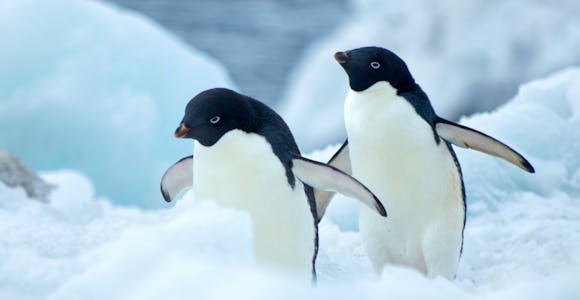
Discover the key penguins you might encounter and find out how to make the most of your time spotting these wonderful animals.
Discover MorePrice Match Promise-We’ll match any price you find elsewhere for the same trip
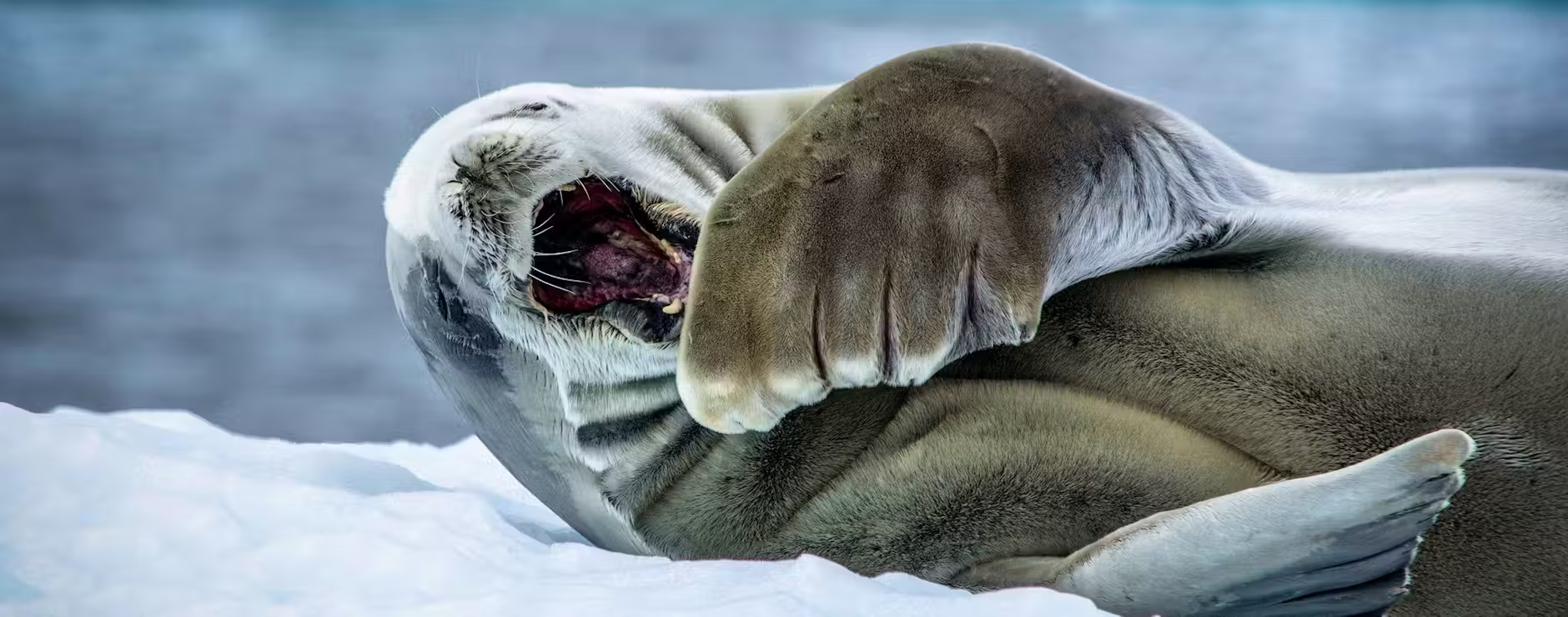
As both predators and prey, seals are key to the Antarctic ecosystem. While they might not receive as much hype as penguins or whales, they're some of the White Continent's most underrated wildlife wonders. Learn more about the seal species you’re likely to spot on your upcoming trip, as well as the distinctive quirks that will help you tell each one apart.
Seals are more than just dark, lumpy shapes sprawled across the ice: they serve as a bridge in the middle of the Antarctic food chain. These creatures keep the polar ecosystem working, whether they’re hunting prey such as fish, penguins and krill or being hunted by orcas.
During your cruise, you're highly likely to see various seal species in all kinds of scenarios: flopped on top of ice floes, hauled out on beaches or popping up beside your zodiac to investigate you with curious eyes.
As seals are sensitive to changes in sea ice, the availability of prey and ocean temperature, they also act as barometers for Antarctica's health. Scientists study seal populations and behaviour to learn more about the effects of climate change.
These crucial and fascinating creatures are the unsung heroes of the White Continent.
A lifelong dream of mine was to see a leopard seal and we saw two on the voyage, both resting on flat ice floes in the most beautiful settings, in bays strewn with icebergs and ringed by snowy mountains. The seals were both stunning and formidable all at once – not just one of the world’s top predators, but a huge highlight for me personally.
Kate Higgs Customer Experience Coordinator
The best time to spot seals in Antarctica is anytime during the travel season, from November to March.
If you're visiting in November, you're in for a treat – most seal pups are born between September and this month, so you'll have a chance to spot these adorable young ones with their parents.
For those travelling a little later in the season, January is prime time for catching sight of fur seal pups, which are born after Christmas. These can often be seen around the northern tip of the Antarctic Peninsula.
No matter when you visit, every wildlife encounter follows strict conservation guidelines to make sure seals aren't disturbed in their natural habitat. Witnessing them in the wild is, after all, a privilege.
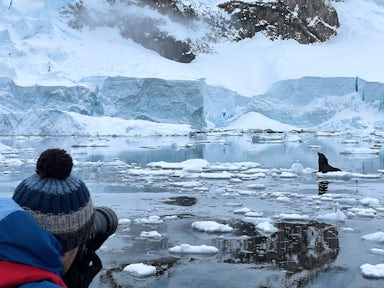
A fur seal at Neko Harbour
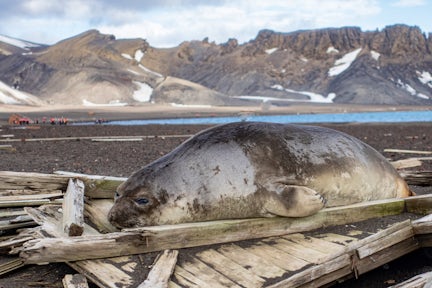
Juvenile elephant seal on Deception Island
Seals might seem relaxed, but they’re still wild animals, so keeping a respectful distance is key. Guidelines stipulate that you should always stay at least 15 feet (5 metres) away and give even more space to fur seals, leopard seals or jousting elephant seals.
If you spot a nursing leopard seal, keep at least 75 feet (25 metres) back. Mothers often leave their pups onshore while feeding, and it’s important not to approach them.
As a rule of thumb, if a seal lifts its head, it’s aware of you. If it moves, you’re too close. Try not to walk between a seal and the sea, and avoid standing over them – a clear view of their surroundings helps them to feel safe.
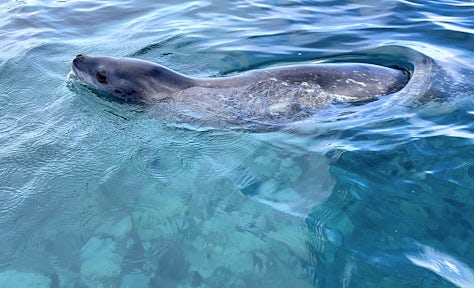
A leopard seal swimming through the water
While it’s always worth spending time on deck watching for wildlife, your best seal-spotting opportunities will likely come as you glide around Antarctica on your zodiac rib boat excursions.
Skimming low over the water might bring you within the eye lines of chunky elephant seals hauled out on the shoreline or dog-like crabeater seals sitting alert on an iceberg. You never know when a curious leopard seal might pop its head up beside you, either.

Watching a leopard seal on an ice floe
The expedition team on your ship includes expert naturalists who know Antarctic wildlife inside and out. Don’t be shy about asking questions – these are the kinds of people who get genuinely excited by seals of all sorts.
Curious about that eerie sound echoing under the ice? It could be the haunting call of a Weddell seal. Or maybe you’re wondering what that blubbery shape on the beach is? Whatever catches your eye, you’ll find the expedition crew are a goldmine of wildlife facts and are usually up for a chat.

An almost camouflaged Weddell Seal
Some seal species can look surprisingly similar – especially when they’re lounging sausage-like in the distance or blending in with the greyish colour of a rocky shore.
This is where a good pair of binoculars comes in handy. With a closer look, you’ll start spotting the subtle details that set different types apart, like the cartoonish wide eyes of a Weddell seal or the sheer bulk of a southern elephant seal.
We’ll dig deeper into how to identify different seal species just below.
There are 33 seal species in the world, six of which are found in Antarctica and the Southern Ocean. Here’s how to identify the four main species you might see during your trip, as well as the two you're less likely to come across.
With a little practice, you’ll be picking out the different species in no time.
Weddell seal
A snoozing Weddell seal
A Weddell seal at Paradise Bay
Weddell seals are the most frequently spotted seal species on the Antarctic Peninsula. While usually seen alone, you might glimpse adult females with their pups early in the season, as they're typically born in October. These seals are impressive deep divers, hunting fish and krill underwater for up to an hour at a time. They’re also surprisingly vocal, often trilling and chirping to defend their territory beneath the ice.
Weddell seals are one of the largest of the species, with a length that can reach more than twice the height of the average human female.
How to identify a Weddell seal:
Where to spot a Weddell seal
Crabeater seals are thought to be the most abundant seal species in the world, yet you can only find them in Antarctica. Their success in this region is down to their food source: not crabs as you might think, but krill. Crabeaters have peculiarly shaped teeth that sieve this abundant stuff out of the water, just like baleen whales do.
These animals are more wary of ships and boats than other seal species, so may just slip into the water as soon as they spot you coming.
How to identify a crabeater seal:
Where to spot crabeater seals:
A leopard seal
Yawning leopard seal
The leopard seal is an Antarctic apex predator, just like the orca. These solidly built animals hunt penguins, meaning you can often find them near busy rookeries, but they also eat anything from krill and small fish up to young crabeater seals. Catch them yawning or displaying and their sharp, prominent teeth might just trigger goosebumps.
Leopard seals are unusual among seals as the female is often bigger than the male, reaching as much as 3.8 metres (12.5 feet) in length. That's about five times as long as the average man's footstep!
How to identify a leopard seal:
Where to find a leopard seal:
Antarctic fur seal
A fur seal on Deception Island
A fur seal on Gaston Island
Hunted almost to extinction for their pelts in the early 19th Century, hearteningly there are now are nearly 4 million fur seals on South Georgia alone. You're more likely to see this species on the Southern Ocean island, but they're still also spotted on Peninsula cruises.
Fur seals swim by porpoising like a penguin and can run faster than a human. They're particularly common in January to March.
How to identify a fur seal:
Where to see fur seals
King penguins and jousting elephant seals
Elephant seals bask at Hannah Point
Elephant seal at Yankee Harbour
You might spot these hefty creatures on the South Shetland Islands, but it all depends on sea and ice conditions. Weighing up to an impressive 4 tons (4,000 kilograms) – about the same as an empty trailer – the males are the largest seal species on the planet. Interestingly, the females are less than a quarter of their size.
If you're visiting South Georgia, where elephant seals are far more abundant than in Antarctica, early in the polar cruise season, you might witness the dramatic battles between males vying for space and mates. Later in the summer, they come together again to shed their old skin in a collective, scruffy-looking moult.
How to identify an elephant seal:
Where to see elephant seals:
One Antarctica species that's hugely rare to see is the Ross seal. This creature breeds south of the Antarctic Circle among the thick pack, so you won't spot it if you're only heading to the Peninsula. Only cruises on icebreaker ships heading east to the Ross Sea stand any chance of a sighting.
How to identify a Ross seal:
Most memorable moment? Seeing a leopard seal catch and flay a penguin reminded me that nature is not cuddly. Read the full review
Travelled: March 2025
Sharon Smith - USA
We were greeted by 4000 lbs elephant seal 'teenagers', penguins and birds. And we had an almost surreal feeling of wow, we actually made it here... and for my wife, it was a step onto land that ended an odyssey to touch all 7 continents! Read the full review
Travelled: March 2025
Rajesh Ramsukh - Canada
The majority of the trip was a memorable moment, but the giant, steaming pile of male elephant seals was incredible! Got some great video of them "talking" to each other. Also got some great video of a close-up humpback whale slapping his fins back and forth.
Travelled: February 2025
Leigh Renkar - USA
10/10 - The penguins, seals, and whales were fun to see, but the best part was seeing the ice and the magnitude of Antarctica. We got off the ship twice most days. Read the full review
Travelled: January 2025
David Bahls - USA
Most memorable moment? Spotting different types of seals and penguins on ice floes from the gorgeous balcony of ship’s cabin. Read the full review
Travelled: December 2024
Koel Taneja - India
Great experience especially through the ice, and watching seals and penguins close up. Read the full review
Travelled: November 2024
Peter Abery - Australia
We saw penguin parties, whales in groups and feeding, seal parties, and different spectacular icebergs, glaciers and scenery. Read the full review
Travelled: March 2024
Winifred Hok-Wing Bacon - UK
I left there more knowledgeable about seals, penguins, whales, clouds, and krill!! The lectures were a great way to make you think about what is in the oceans, where you live, and everywhere. Read the full review
Travelled: February 2024
Debra Sharkey - USA
Most memorable moment? The leopard seal and that terrifying yawn / grin was impressive. Hundreds and thousands of penguins; they are almost as fun to watch walking as it is to watch them swim! The icebergs are overwhelming in size. Read the full review
Travelled: December 2023
Howard Witbeck - USA
Review:

Discover the key penguins you might encounter and find out how to make the most of your time spotting these wonderful animals.
Discover More
Spotting whales in all their glory is a highlight of an adventure to Antarctica. Our guide will help you discover more about the species you might see.
Discover More